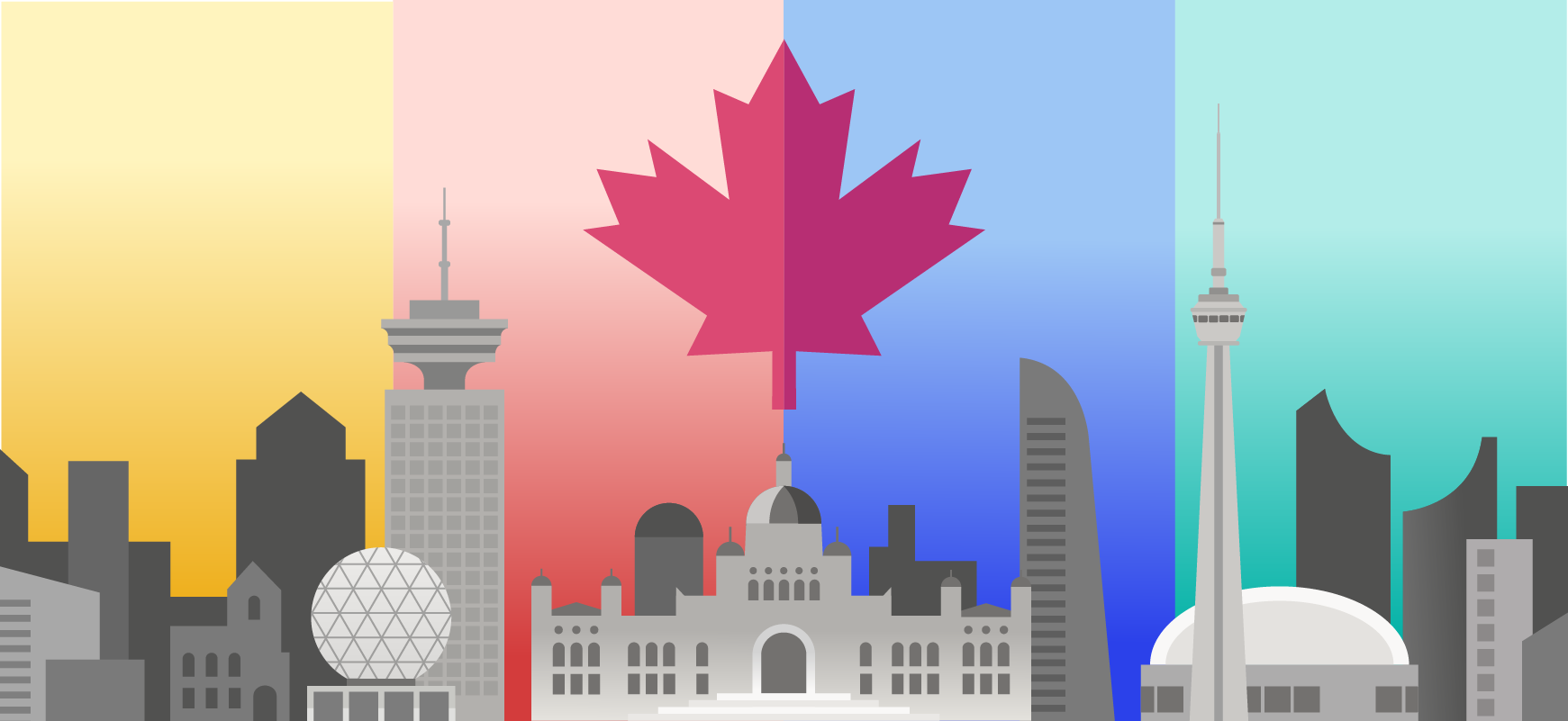As COVID-19 vaccination rates in Canada continue to rise and public health measures are lifting across provinces, consumers are eager to gather with friends, dine out, travel, and more to make up for seemingly lost time.
A word of caution: the potential surge in “revenge spending”, if not managed responsibly, may hurt consumers in the long-run — credit utilization is a key factor that impacts consumers’ credit scores. Additional spending on credit cards and credit lines can lead to high credit utilization and can prevent Canadians from reaching their future financial goals.
To get a snapshot of credit utilization rates and revolving credit balances across Canada, Borrowell, a fintech company that offers free credit report monitoring, analyzed over 978,000 credit reports of its members, including those in 20 major cities across Canada for Q2 2021 to-date (April and May 2021). The goal of this study is to help consumers understand how additional spending on credit cards and lines of credit as the country opens up may impact their credit scores and thus hinder future goals that require getting lending products, such as buying a home or other large purchases.
A surprising (potentially alarming) finding was that average consumers across nearly all the cities included in the study already had credit utilization rates above the recommended threshold of 30%, with the Canadian average being 43.5%. The infographic below shows the credit utilization and revolving balances for 20 major cities in Canada.
Note: Credit reports were pulled from Equifax Canada.
Key FindingsThe average credit utilization rate in Canada in Q2 2021 was 43.5%, which is higher than the recommended rate of 30% for maintaining a good credit score
The average revolving balance of credit cards and lines of credit in Canada in Q2 2021 was $10,361
Markham is the only city out of the 20 major Canadian cities in our study that has an average credit utilization rate below the recommended rate of 30%
Markham, Vancouver, and Burnaby have the lowest average credit utilization rates at 29.2%, 32.6%, and 33.2%, respectively
Moncton, Quebec, and Edmonton have the highest average credit utilization rates at 54.0%, 48.0%, and 47.4%, respectively
What is Credit Utilization and Why Does It Matter?Credit utilization is the amount of revolving credit a consumer has used out of the total amount of revolving credit available to them and is calculated as their revolving balance divided by their total credit limit.
Revolving credit includes credit cards and lines of credit (such as personal lines of credit or home equity lines of credit) that can be used and repaid on an ongoing basis. Each revolving credit account has a maximum credit limit that a consumer has available to use.
A low credit utilization rate means the consumer is only spending a small portion of their credit limit, while a high credit utilization rate means the consumer is spending most of the credit available to them and could possibly indicate they are having trouble managing their finances.
The recommended credit utilization rate to maintain in Canada is 30% or lower. This can help consumers demonstrate to lenders that they are a responsible borrower and aren’t stretched thin financially.
Average Credit Utilization in Canada is 43.5% Borrowell’s study reveals that the average credit utilization rate of Canadian consumers is 43.5%, which is significantly higher than the recommended threshold of 30%. Average credit utilization has trended slightly down in Q2 2021 compared to the previous year, as consumers have had less opportunity to spend and adopted more cautious financial habits. This downward trend has been noticeable across all the cities included in this study.
Canadian consumers are carrying an average revolving balance of $10,361. Based on the average credit utilization rate of 43.5%, the implied average total revolving credit limit of Canadian consumers is about $23,795. The average Canadian consumer has about 2.4 revolving credit accounts open.
The 11 cities in this study with credit utilization below Canada’s average rate are either in B.C., Ontario, or Quebec. Markham had the best (lowest) credit utilization at 29.2%, and major cities like Vancouver, Toronto, Ottawa, and Montreal have credit utilization rates of 32.6%, 33.8%, 37.4%, and 38.4%, respectively.
The 9 cities in this study with credit utilization above Canada’s average rate are mostly situated in the Prairie and Atlantic provinces. Moncton had the highest credit utilization of the cities in the study, with a credit utilization of 54.0% and revolving balance of $6,490. Edmonton, Saskatoon, and Calgary have credit utilization rates of 47.4%, 47.4%, and 43.8%, respectively.
Markham: The Only City Under 30% Credit UtilizationOut of the 20 Canadian cities included in this study, only one city has an average credit utilization below the recommended rate of 30%. Markham has an average credit utilization of 29.2%, just slightly below the recommended rate.
Markham consumers have an average revolving balance of $15,995, which is 53% higher than the Canadian average revolving balance. That said, Markham consumers have an average of 3.2 revolving credit accounts open and an average credit limit of $56,056, which is 129% higher than the Canadian average credit limit. This high credit limit relative to revolving balance is helping Markham consumers keep their credit utilization low.
With credit utilization being the second largest factor that impacts credit scores (second to bill payment history), the low credit utilization of Markham consumers has helped them achieve the highest average credit score in Canada, as highlighted in Borrowell’s previous study on average credit scores in Canada.
Credit Utilization May Rise Further as Spending IncreasesMany Canadians adjusted their saving and spending habits over the past year due to COVID-19 restrictions. According to RBC, Canadian households accumulated $212 billion in savings in 2020 ($184 billion above pre-COVID levels), driven by increased government support programs and limited spending options. With the country opening up again, spending habits are expected to change.
“Naturally, many Canadians will be increasing spending on food, clothes, social activities, travel, and more as the country gradually opens up to a new normal,” says Andrew Graham, co-founder and CEO of Borrowell. “But they should be cautious about ‘revenge spending’ after the past 16 months. Average credit utilization in Canada is already above the recommended rate of 30%, and this could increase even further as more and more opportunities to spend become available.
“We encourage Canadians to manage their finances cautiously over the next few months. Racking up credit card debt over the summer months can strain credit utilization rates and credit scores, putting long term financial goals at risk.”
Four Tips For Canadians to Achieve a Credit Utilization of 30% or LowerTo achieve and maintain a credit utilization rate of 30% or below, consumers should work on minimizing their revolving credit balances or increasing their revolving credit limit. To check what those numbers are, consumers can manually tally up their balances and credit limits or use an app like Borrowell that provides free credit scores and reports and automatically calculates credit utilization.
Based on Borrowell’s experience and data, here are top tips to help Canadians reduce their credit utilization and improve their credit scores in the long-term.
1. Reduce current credit card balances: Consider paying expenses with your debit card instead of credit cards. Using debit to pay expenses can help you lower your credit card balances and reduce your credit utilization.
To calculate how much you need to lower your credit balance by to reach a 30% credit utilization rate, multiply your credit limit by 0.30 and look at the difference between that figure and your current revolving balance.
2. Transfer credit card debt into a debt consolidation loan: A debt consolidation loan can help you combine multiple sources of debt into one manageable payment. Transferring your credit card debts into one loan will lower your credit utilization because loans are considered installment credit, which aren’t included in credit utilization calculations.
3. Increase credit limits on existing revolving accounts: Call your current lenders and ask for credit limit increases on your existing accounts. If you have a fair credit score and a solid payment history with the lender, they will be more likely to approve your request. If you increase your credit limit, be disciplined with the new credit available to you. Don’t be tempted to spend more with your increased credit limit; the purpose of increasing your credit limit is to decrease your credit utilization rate while keeping your debt levels the same.
To calculate how much you need to increase your credit limits by to achieve a 30% credit utilization rate, divide your current balance by 0.30 and then look at the difference between that figure and your current credit limit.
4. Open another credit card or line of credit: Opening another revolving credit account is a simple way to increase your total credit limit and decrease your credit utilization, assuming you don’t also increase your spending levels. Open a credit card and make a small purchase once a month to keep the account open. Be disciplined about the new amount of credit available to you. The purpose of opening another revolving credit account is to increase your total credit limit, not take on additional debt. Also not that, if you don't use your credit card for small purchases on a regular basis, your lender may cancel your credit card, which will quickly decrease your credit limit and increase you credit utilization.
Infographic: Average Revolving Debt & Credit Utilization Across CanadaCredit Utilization Stats by CityCities with Highest Credit Utilization Rate, Q2 2021
Moncton: 54.0%
Quebec: 48.0%
Edmonton: 47.4%
Saskatoon: 47.4%
Regina: 46.9%
Cities with Lowest Credit Utilization Rate, Q2 2021
Markham: 29.2%
Vancouver: 32.6%
Burnaby: 33.3%
Toronto: 33.8%
Mississauga: 35.2%
Cities with Highest Revolving Balance, Q2 2021
Markham: $15,995
Vancouver: $13,531
Burnaby: $13,407
Surrey: $12,567
Calgary: $12,382
Cities with Lowest Revolving Balance, Q2 2021
Moncton: $6,490
Quebec: $6,646
Winnipeg: $6,992
Halifax: $7,145
Hamilton: $7,288
Methodology
Report findings are based on historical credit report data of over 978,000 Borrowell members in Canada for April and May 2021 (Q2 to-date 2021 at the time of publishing). Findings may not represent the entire population. Credit reports of Borrowell members are provided by Equifax.
Revolving credit includes credit cards and lines of credit (such as personal lines of credit or home equity lines of credit) - each account has a maximum credit limit and the balance that isn’t paid off can be carried over from month to month.
Credit utilization is calculated as the total balance on all revolving credit accounts divided by the total credit limit on all revolving credit accounts. Credit utilization shows a consumer how much credit they are using relative to the total amount available to them. Keeping credit utilization under 30% is recommended to maintain a good credit score.
Cities in this study are based on locations provided by members when they sign up for Borrowell.
Media Contact
For media inquiries and interviews, please contact [email protected]









